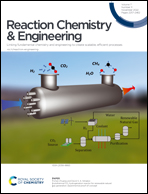Production of γ-valerolactone over mesoporous CuO catalysts using formic acid as the hydrogen source†
Abstract
In the present study, the conversion of levulinic acid (LA), butyl levulinate (BL), and ethyl levulinate (EL) to valuable biomass-derived compound γ-valerolactone (GVL) is studied. A series of mesoporous CuO catalysts prepared through the hard template method were used in combination with formic acid (FA) as the hydrogen donor for the reduction of LA and levulinate esters. The catalysts are characterized using analytical and physical methods such as XRD, FESEM-EDX, and nitrogen adsorption–desorption, hydrogen temperature-programmed reduction, and TEM techniques. Among the samples, mesoporous CuO which was reduced under a hydrogen atmosphere exhibited higher activity in the cascade formic acid decomposition and hydrogen transfer to alkyl levulinates, followed by the ring closure and formation of γ-valerolactone. The effect of influential factors including the amount of catalyst, reaction temperature, levulinic acid and alkyl levulinate amount to formic acid ratio, and reaction time on the conversion of substrates and GVL yield was also investigated. According to the obtained results, 50 mg of the mesoporous CuO catalyst, 180 °C as the reaction temperature, and 5 h as the reaction time were selected as the optimum reaction conditions.



 Please wait while we load your content...
Please wait while we load your content...